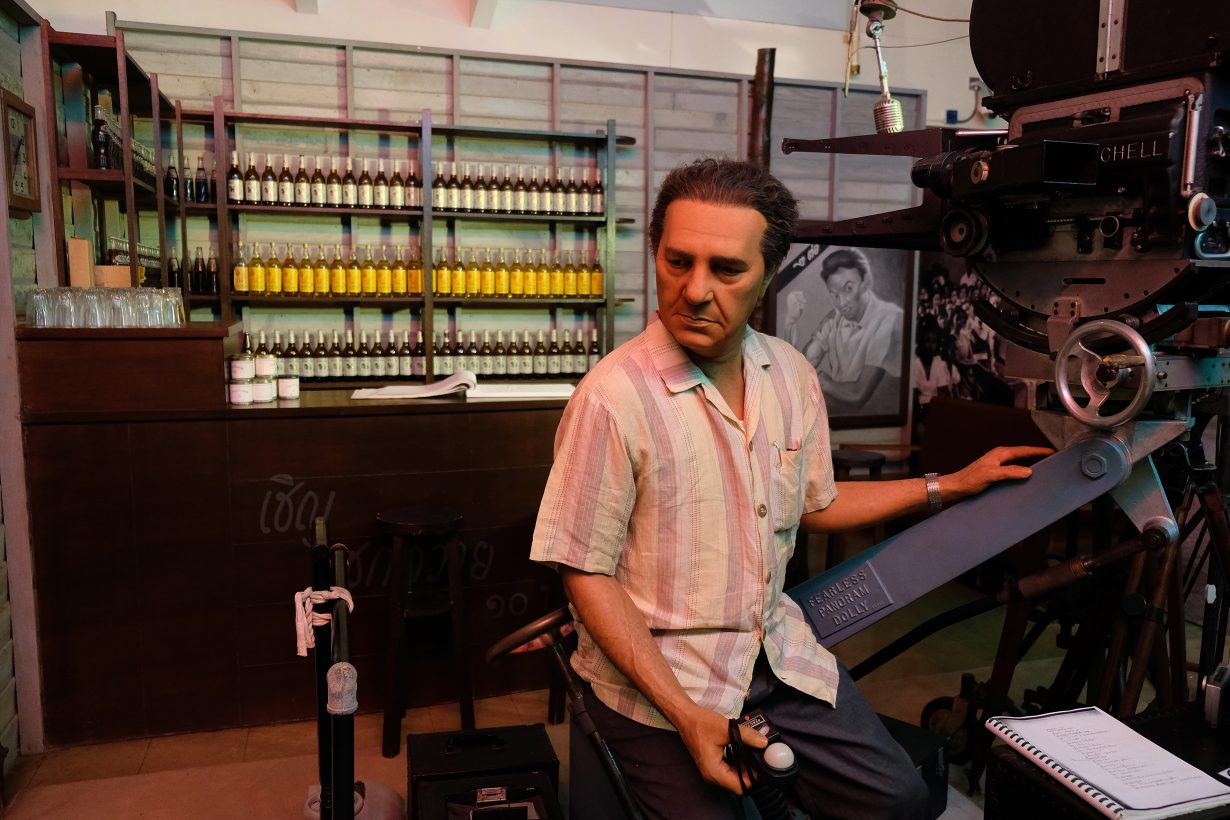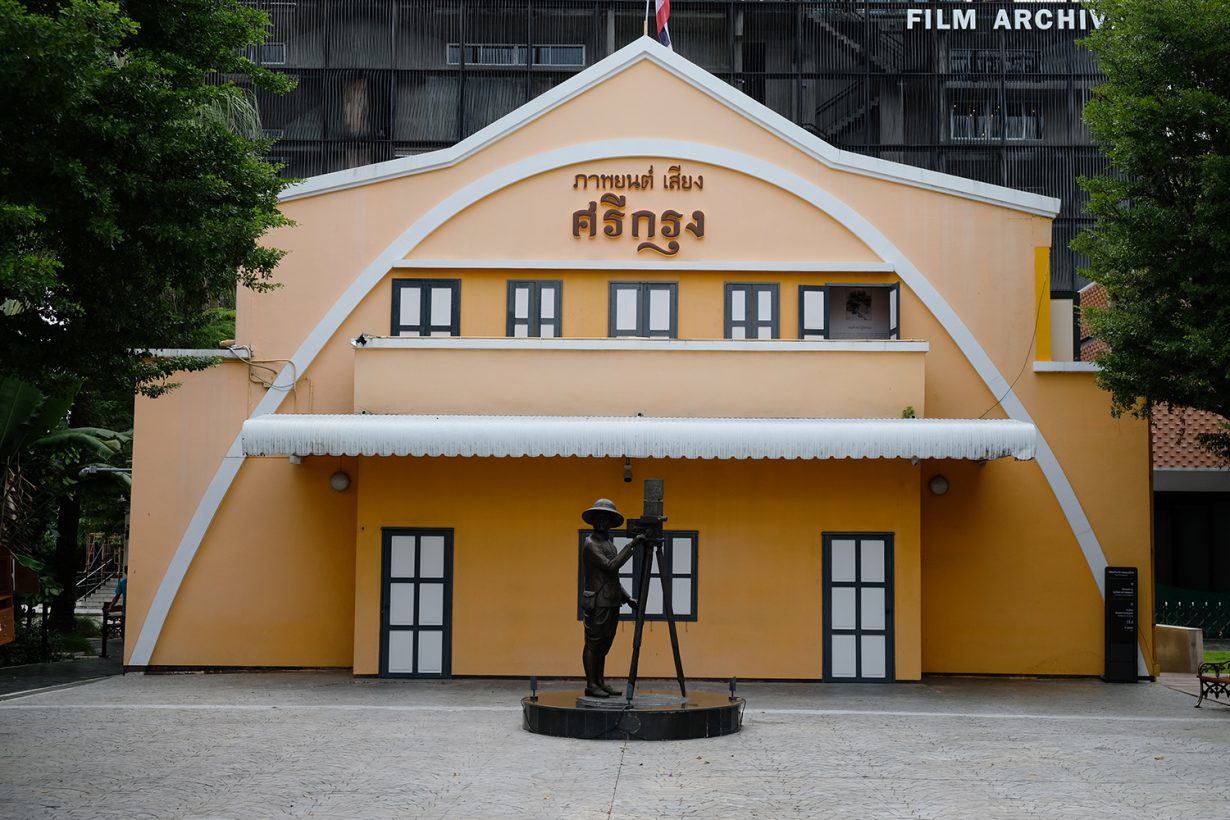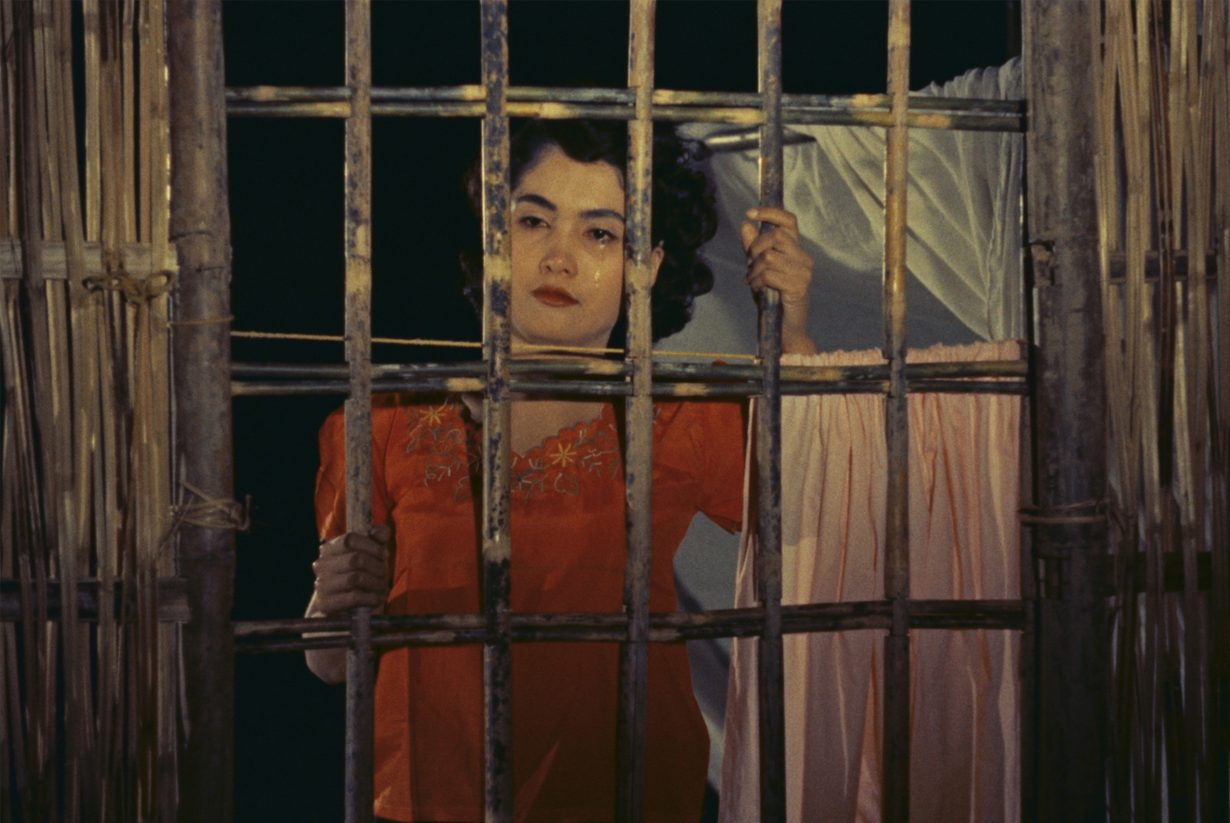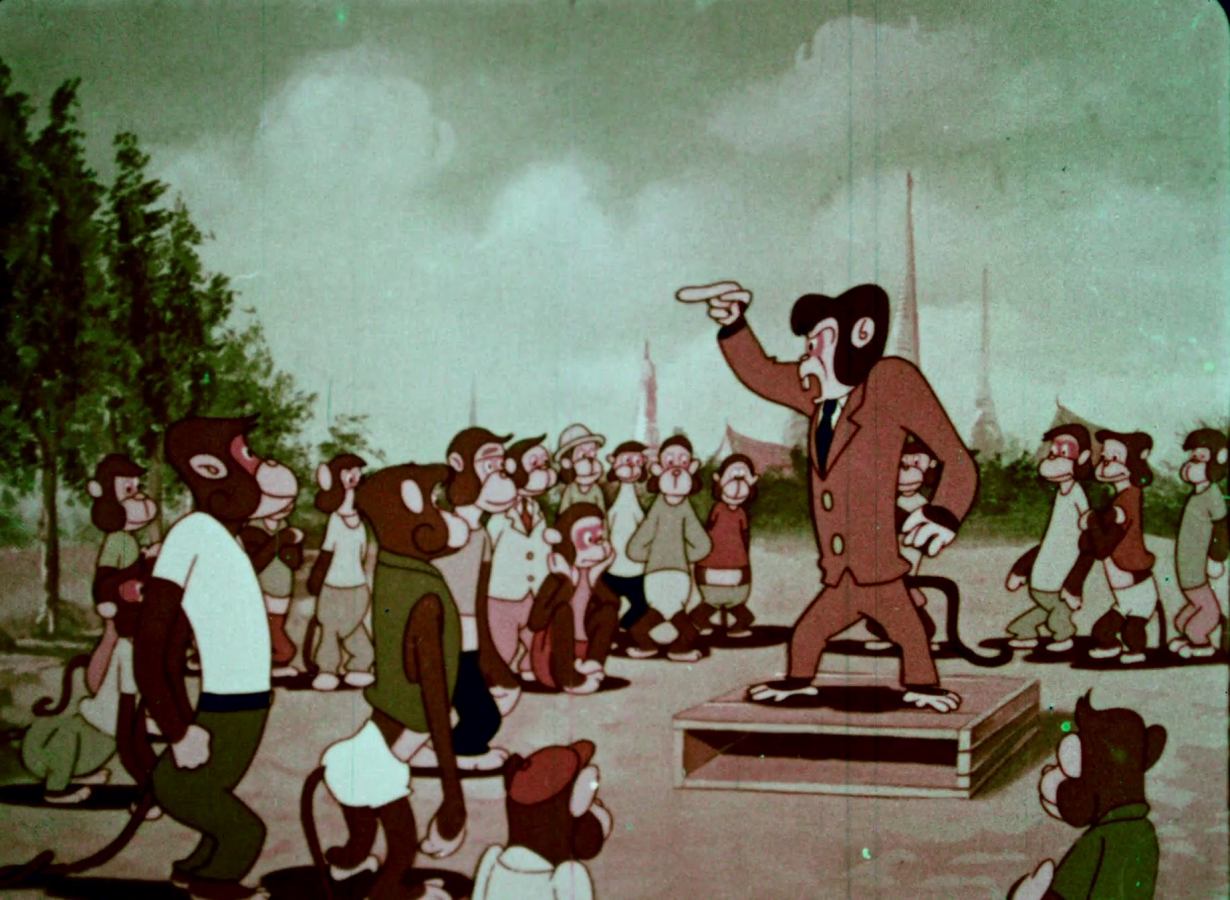The twisted history of one of Thailand’s most generous and eclectic cultural institutions
All national film-archives strike a balance between preservation and distribution, between ‘saving’ films and sharing them. Yet very few, I suspect, possess the zany, something-for-all appeal of the Thai Film Archive, a sprawling and somewhat piecemeal facility sequestered beside a university campus on the nondescript outskirts of Bangkok (about 25km from the city centre).
At first glance, the compound it has occupied since 1997 resembles a film-history themepark specialising in ‘edutainment’. Walking from the carpark towards the entrance, visitors pass an antique steam locomotive with a lifesize bronze sculpture of Jean Gabin – star of Jean Renoir’s train-bound drama La Bête Humaine (1938) – manning the controls. It is joined by a replica of Thomas Edison’s 1893 proto-studio, the Black Maria, more statues of early motion-picture icons (Eadweard Muybridge, Charlie Chaplin) and an outdoor set recreating a movie-studio backlot. Inside the ersatz city buildings of the latter, the advent of moving image is explained through reconstructed environments, from New York’s first Kinetoscope parlour to a dainty Parisian cinema.

Photo: Max Crosbie-Jones
These concessions to less cine-literate audiences join a wealth of displays and exhibitions devoted to Thai film history. Among the earliest structures built on the site is a reconstruction of one of Bangkok’s first film studios, the long-demolished, pale-yellow Sri Krung. The two-storey museum housed inside needs rejigging, I think. The chronological story told upstairs – which kicks off with shadow puppets, zoetropes and King Rama V (1868–1910) watching a cockfighting short on Edison’s Kinetoscope in Singapore in 1896 – is somewhat obscured by the piles of film paraphernalia that have built up over the years. But there is some wonderful stuff in here. Joining the centrepieces – the bar from delightful black-and-white comedy caper Rong Raem Narok (Country Hotel, 1957) and a waxwork figure of its Thai-Persian director, Rattana Pestonji (the first Thai filmmaker to use 35mm film and gain international plaudits) – are mock animation, costume, poster and subtitle studios, while cabinets groan with awards, scripts, storyboards and props.
Back outside, an exhibition in a vintage train-carriage sheds light on that incongruous steam locomotive: Purachatra Jayakara, Prince of Kamphaengphet (1881–1936), who oversaw the expansion of Thailand’s rail network, was an early adopter of film, and the state railway department’s Topical Film Service, founded in 1922, the first producer of documentaries and newsreels. And in the compound’s latest addition – a sleek six-storey cinematheque housing three theatres, a library, a giftshop and exhibition spaces – more recent legacies are explored. The Spaceship of Nabua is a permanent collection of props from Apichatpong Weerasethakul’s Primitive (2009), the short film-cum-research project, centred on a small village in the northeast, that spurred Uncle Boonmee Who Can Recall His Past Lives (2010). Primitive’s oval bamboo spaceship sits atop an airy auditorium, awaiting liftoff. It is one of many permanent and temporary film-history shrines housed in this wood-accented concrete behemoth, which apparently draws spiritual inspiration from Buddhist architecture, namely phutthawat, the temple zone dedicated to public worship.

Exploring all this, I am struck by a couple of issues. Firstly, for all the accessibility of its programming, the archive itself has an access issue. Space has come at the price of visibility and footfall. Consequently, the archive’s ever- expanding library is – despite efforts at outreach, such as open-air cinema seasons and a mobile cinema truck that tours the country – not as widely appreciated as it could be. This is a shame, especially given that there are civic art-spaces in the capital with barren rosters and space to fill. Also, the archive’s inside story, from its hard-won battle for existence through to its storage and lab facilities, cross-border detective work (the latest find: Dead Man’s Voice, 1954, an anticommunist Thai film-noir commissioned by the United States Information Service), digital workflows and recently acquired ability to restore films inhouse, isn’t a part of the visitor experience. I think it should be.
That said, I would understand if they decided to leave the hardscrabble early years of the archive on the proverbial cutting-room floor, for fear of causing the authorities to lose face… In 1981 a film scholar named Dome Sukvong – now officially retired, although this hirsute seventy-one-year-old is still a hired specialist – discovered a batch of 35mm nitrate negatives in a State Railway of Thailand storeroom. But not until 1984, the year the Swedish Film Institute sent him a reel containing King Chulalongkorn’s 1897 visit to Stockholm, did his dream of a state-funded film archive find tentative backing. ‘Uncalled for, unpaid, unofficial and unsubsidized as we are, we are nevertheless making some progress in our work,’ he wrote in the 1984 International Federation of Film Archives Information Bulletin. That progress proved painfully slow, however. For years, the archive operated out of a deserted building that once belonged to the Royal Thai Mint – and scraped by with only a few staff and meagre budget. It was also hobbled by a lack of autonomy: until 2009, when it became a public organisation, its budgets were controlled by the government’s Fine Arts Department. Simply put, years of making nice with officials who didn’t quite grasp or get Sukvong’s vision – a vision always more expansive and less elitist than what initially piqued their shallow interest, namely early films of royal events and the filmmaking legacies of a few foresighted Thai princes – got the archive where it is today.

Thankfully, much of the archive’s hard work has been nicely packaged for public consumption. Its page on the Google Arts & Culture platform boasts slick online versions of its offline temporary exhibitions. A recent collaboration with Netflix saw it curate 19 remastered films representative of Thai film-history of the past 50 years, albeit only for viewers in Thailand. And while next to nothing survives of pre-Second World War films – ‘1981, when Dome started, was too late for many things’, Thailand Film Archive’s current director, Chalida Uabumrungjit, lamented back in 2015 – the archive’s YouTube page catalogues hundreds of its finds, with more being added by the month. Together these films form an astonishing cavalcade of Thai life, in all its joyous and messy, and often conflict-riven diversity.
Here you won’t find the film-age expansiveness of the BFI Player or the USA’s Library of Congress, but you will find meaty playlists like Gon Phaya Mar (‘Before the Storm Comes’), a 20-strong documentary collection centred on mid-1970s social and political unrest. One click takes you to They Will Never Forget (1977), which explores the protest movements of the period; another click to Hara Factory Workers Struggle (1975), about one of Thailand’s most famous labour disputes. Other playlists showcase key political events, Bangkok life, orientalist travelogues and highlights from Rattana Pestonji’s illustrious back catalogue.
The staggering eclecticism reflects the years of diligent retrieval and repatriation by the archive’s ‘Movie Rescue Unit’, as well as an open-armed acquisitions policy that finds almost nothing being refused, even home movies. “Some archives are more selective because they don’t have the space, or maybe they have independent archives that collect those kinds of things, but we collect anything made by Thais or related to Thailand,” says Uabumrungjit. Not all these curios are fully restored. Some are simply scanned and colour-corrected before uploading, yet most are interesting despite their audiovisual imperfections. Or perhaps because of them? For me, the abrasive quality and middling shape of, say, Saming Baan Rai (1964) – one of many hammy schlockfests that Thai cinema’s ‘golden couple’ Mitr Chaibancha and Petchara Chaowarat helmed during the 1960s – is part of the history lesson and much of the evocative, time-warp charm. After all, scratchy prints and poorly synced, tinny sound were pretty much a given for Thai cinemagoers in the 16mm era, a period during which only a few copies of each film circulated and live sound dubbers, who were often big stars themselves, voiced the onscreen characters.

Despite their cultural and historical importance, such antediluvian genre-movie relics are unlikely to be watched start-to-finish by most – especially foreigners, given the lack of subtitles in most cases. Other films, though, are both appealing and edifying, hold our attention with artistry, drama or humour while reshaping or expanding our understanding of Thai society or mores.
The New Adventures of Hanuman (1957), for example, is a fascinating entry point into the output of Payut Ngaokrachang, Thailand’s most famous cartoonist. Early works were pure and innocent – his first animated short centres on a man gaily sniffing flowers – but at the height of the Cold War, he was commissioned to produce anticommunist allegories such as this propulsive tale of monkeys, set to tense orchestration, overcoming fanged giants. And equally engrossing, but clearly aimed at a more niche grown-up audience, is a 12-minute silent slapstick comedy entitled It’s All Because of a Katoey (1954). Shot by amateurs and depicting a transgender woman who dupes a man into marrying her, it is, says the archive, ‘the oldest Thai film with an LGBT character ever discovered’ – and more progressive than much of what passes for Thai entertainment these days.
As I said, something for all.
